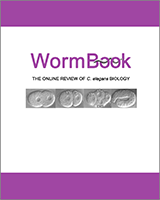| Dopamine | Dopamine receptors | DOP-1, DOP-310, 28 | Inhibits locomotion1, 13, 10. Inhibits egg laying1, 2. Inhibits defecation2, 13. Increases frequency of high-angled turns25. |
| Serotonin | Serotonin receptors | SER-126, 27, SER-226, 5, MOD-517
MOD-113, 14 | Inhibits locomotion11, 3, 13. Inhibits defecation2, 11. Stimulates pharyngeal pumping11, 3, 8, 6 (in the absence of food). Stimulates egg laying2, 3, 7, 12. Causes male tail curling4. Causes reduced sensitivity to aldicarb-induced paralysis21. Stimulates vulval muscle calcium transients22. Inhibits HSN calcium transients22. Inhibits olfactory adaptation24. |
| Octopamine | Octopamine receptors | | Causes uncoordinated locomotion3. Inhibits pharyngeal pumping3, 8, 6 (in the presence of food or 5-HT). Inhibits egg laying3, 11 (in the presence of food or 5-HT). Inhibits defecation2, 3. |
| Tyramine | Tyramine receptors | SER-25 | Inhibits egg laying (5, 9) (in the presence of food or 5-HT). |
| Quinpirole | Dopamine receptors (agonist) | | Inhibits locomotion11. Inhibits egg laying11. |
| Chlorpromazine | D2 receptors (antagonist) | | Stimulates egg laying2. |
| Raclopride | Dopamine receptors (antagonist) | | Blocks the effects of dopamine on turning frequency25. Eliminates area-restricted search behavior25 |
| α-methyl 5-HT | Serotonin receptors (agonist) | SER-129 | Stimulates egg laying23. |
| Methiothepin | Serotonin receptors (antagonist) | MOD-114 | Blocks 5-HT-induced inhibition of locomotion13. Causes defects in enhanced slowing13. Causes hypersensitivity to aldicarb-induced paralysis21. |
| Mianserin | Serotonin receptors (antagonist) | MOD-114 | Blocks 5-HT-induced inhibition of locomotion13. Causes defects in enhanced slowing13. |
| Gramine | Serotonin receptors (antagonist) | | Inhibits pharyngeal pumping8. |
| Ketanserin | Serotonin receptors (antagonist) | | Causes hypersensitivity to aldicarb-induced paralysis21. |
| Fluoxetine | Serotonin-specific reuptake transporter (inhibitor) | MOD-5 and others16, 17, 26 | Stimulates egg laying2, 16. Potentiates enhanced slowing response13, 17. Stimulates nose contraction16. Inhibits locomotion16, 21. |
| Paroxetine | Serotonin-specific reuptake transporter (inhibitor) | | Stimulates nose contraction16. |
| Clomipramine | Serotonin reuptake transporter (inhibitor) | | Stimulates egg laying2. Stimulates nose contraction16. |
| Imipramine | Monoamine reuptake transporter (inhibitor) | EGL-218 | Stimulates egg laying2, 12, 19. Stimulates pharyngeal pumping20. |
| Reserpine | Monoamine vesicular transporter (inhibitor) | | Stimulates locomotion15 (in the presence of food). Inhibits egg laying15. |
| Phentolamine | Octopamine and adrenergic receptors (antagonist) | | Stimulates egg laying3. |
